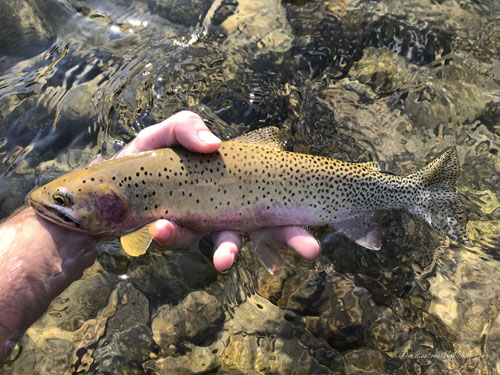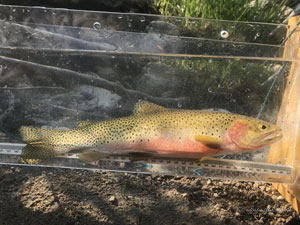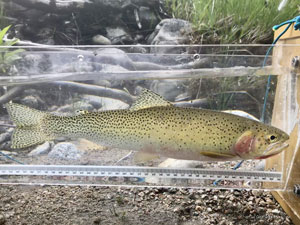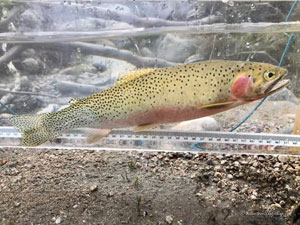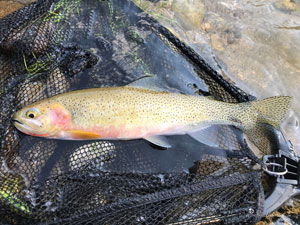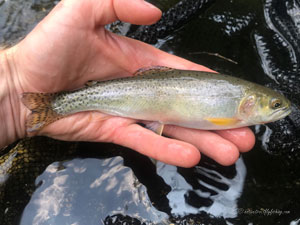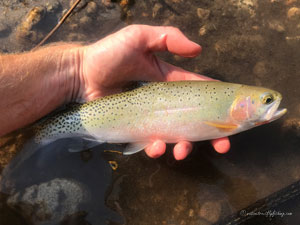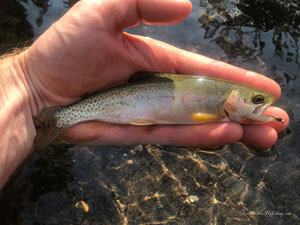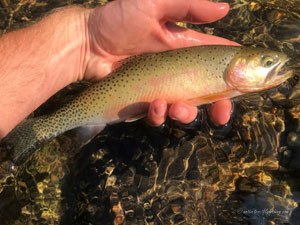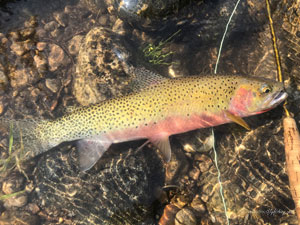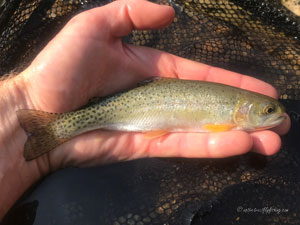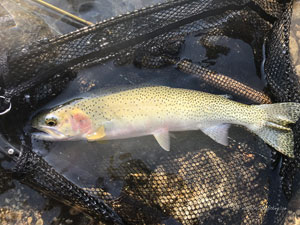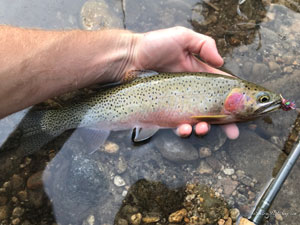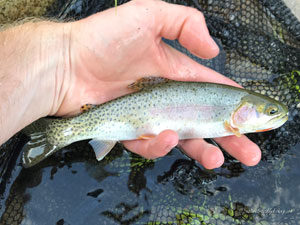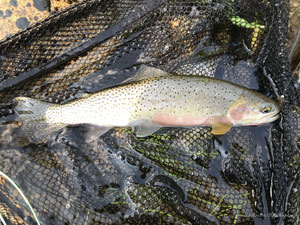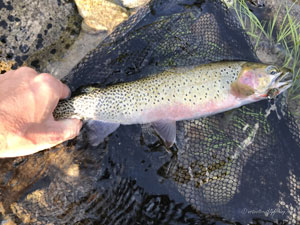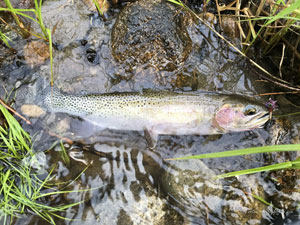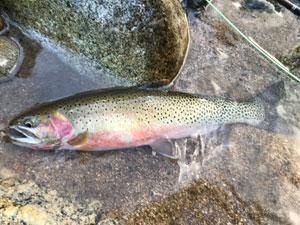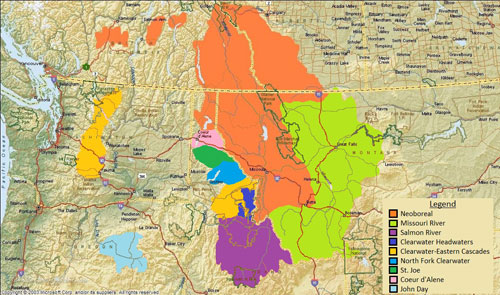Clearwater Headwaters Westslope Cutthroat
Oncorhynchus lewisi ssp.
A fluvial Clearwater Headwaters Westslope Cutthroat from an Idaho stream.
Introduction
The Clearwater Headwaters Westslope Cutthroat has one of most restricted native range of any of the Westslope Cutthroat subspecies with two disjunct populations. One of these populations is found in the Upper Selway upstream of Selway Falls and another in the South Fork Clearwater approximately upstream of the Crooked River although the exact boundary is currently not known. As there are no complete migration barriers separating the Clearwater Headwaters Westslope Cutthroat from the Eastern Cascade-Clearwater Westslope Cutthroat downstream, there are likely zones where the two subspecies mix, and intermediate forms are present. However, it is also possible that summer water temperatures may also help to segregate the two subspecies in the South Fork Clearwater drainage. While this subspecies of Westslope Cutthroat has not been formally described, it is genetically distinct enough to be classified as a distinct subspecies (Trotter et al. 2018, Young et al. 2018).
Life History Information
The life history of the Clearwater Headwaters Westslope Cutthroat Trout is poorly understood but is thought to be similar to other subspecies of Westslope Cutthroat. These Cutthroat predominately exhibit stream resident and fluvial (river migratory) life histories, although adfluvial (river to lake migratory) populations are likely present in some of the lakes throughout its range. Stream resident populations are common in many of the smaller tributaries although no formal life history studies have been conducted on stream resident populations of this subspecies. Fluvial Cutthroat are common in both the Selway River and South Fork Clearwater River and are believed to migrate downstream into the main stem rivers at between age-2 to age-4 and migrate throughout the river system to maximize growth (IDFG 2013). In stream reaches where water temperatures exceeded the thermal tolerance of Westslope Cutthroat (72 °F or 22.0 °C), these fish will move into tributaries seeking thermal refugia where they rear throughout the summer months (Dobos et al. 2016). Fluvial fish generally reach a maximum size of 17” (43 cm), preying on aquatic and terrestrial invertebrates as well as small fish. In additional to upstream summer migrations into tributaries, starting in August and September these Cutthroat migrate downstream up to 62 miles (100 km) to overwinter in deep pools and will migrate back upstream in the spring once water temperatures begin to warm. In the South Fork of the Clearwater River, upstream spawning migrations have been observed from April to July, with fish starting to fall back from spawning locations in June (Dobos et al. 2016).
Status
The Clearwater Headwaters Westslope Cutthroat Trout represent a rare case where a subspecies of Cutthroat is relatively intact across its native range. These Cutthroat are currently thought to occupy 94% their historic habitat in the upper Selway River and 90% in the South Fork Clearwater River (Shepard et al. 2003). The Selway watershed is a stronghold for these Cutthroat with 0.48/100m2 larger than 12” (31 cm) in the mainstem (Hand et al. 2021). This is likely due primarily to the rugged and remote nature of the area that these fish inhabit as well as the fact the majority of the of land is managed by the United States Forest Service, with 95% of the Selway drainage protected in either wilderness areas or roadless areas (IDFG 2013). Starting in 1976, fishing for Cutthroat in the Selway River became catch and release only and within a year of these change the percent of Cutthroat over 12” (30 cm) increased from 12% to 19.2% and by 1986 the abundance of Cutthroat in the watershed had tripled (IDFG 2013, Mallet 2013). Due to the quality of the habitat and catch and release regulations Cutthroat densities in the Selway River and its tributaries have been stable since 1988 (Hand et al. 2021). In comparison Cutthroat densities on the South Fork Clearwater River are among the lowest observed in Idaho at 0.004/100 m2 larger than 12” (31cm) and have not improved since catch and release regulations were adopted in 2011, suggesting that harvest was is not the primary factor limiting Cutthroat in the watershed (Hand et al. 2021). Less than 70% of the South Fork of the Clearwater watershed with U.S. Forest Service lands and the drainage has been heavily impacted from logging, grazing, mining and road construction, altering the natural flow dynamics and temperature regime in the river, limiting the available stream habitat for Cutthroat. Due to this Westslope Cutthroat are generally not found the lower river and instead concentrate in the middle river, where temperatures are cooler than both the lower and upper part of the watershed (Dobos et al. 2016).
Hybridization with hatchery Rainbow Trout does not appear to be a major issue in the Selway population. Hatchery Rainbow Trout were stocked in the lower river downstream of the Clearwater Headwaters Westslope Cutthroat’s native range, but this practice was discontinued in 1990. Stocking of hatchery Rainbow Trout continued until 2011 in the South Fork Clearwater at a number of sites throughout the watershed. It is likely that there has been some level of hybridization between Rainbow Trout and Clearwater Headwaters Cutthroat, as a study in the neighboring Locsha and North Fork Clearwater rivers hybridization was found in sites where Rainbow Trout had been planted (Weigel et al. 2003). Based on phenotypic traits at the smolt trap on the South Fork Clearwater River, about 5% of the Cutthroat appeared to have hybrid characteristics (IDFG 2013). In addition to hatchery Rainbow Trout, Brook Trout have also been stocked in several tributaries of the South Fork Clearwater and likely have negative impacts on the Cutthroat populations due to competition and predation. Despite the impacts of these non-native fish and habitat degradation, overall, the Clearwater Headwaters Westslope Cutthroat remain one of the more intact subspecies of Cutthroat across the West.
Description
The Clearwater Headwaters Westslope Cutthroat Trout are similar in appearance to other Clearwater River drainage Westslope Cutthroat, although they are not typically as deep bodied as the North Fork Clearwater Westslope Cutthroat. The coloration on the backs and sides of these fish is typically an olive to bronze color. The bellies and gill plates typically show a peach to bright orange color and this same color may be found along the lateral line, often between the parr marks on smaller individuals. Spots are typically irregularly shaped, small to medium sized and concentrated towards the posterior region of the body and along the back with relatively few spots found below the lateral line in the middle of the body. Their fins typically are a yellow to orange or peachy color and spots are typically found on the dorsal, adipose, caudal and anal fins.
Fluvial Form
Click on images to view a larger picture
Native Range
Above: A map of the native range of the Westslope Cutthroat trout. Data Sources: Behnke (2002), Trotter (2008) and Young et al. (2018). Below: A map of the native range of the Clearwater Headwaters Westslope Cutthroat Trout.
References
Dobos, M.E., M.P. Corsi, D.J. Schill, J.M. Dupont, M.C. Quist. 2016. Influences of summer water temperatures on the movements, distribution, and resource use of fluvial Westslope Cutthroat Trout in the South Fork Clearwater River basin. North American Journal of Fisheries Management 36:549-567.
Hand, R., S. Wilson, D. Hannasch, J. Renner and J. DuPont. 2021. Idaho Department of Fish and Game fishery management annual report: Clearwater region 2017. Idaho Department of Fish and Game, IDFG 21-107, Final Report, Boise, Idaho.
IDFG. 2013. Management plan for the conservation of Westslope Cutthroat Trout in Idaho. Idaho Department of Fish and Game. Fisheries Bureau, Boise, Idaho.
Trotter, P., P. Bisson, B. Roper, L. Schultz, C. Ferraris, G.R. Smith and R.F. Stearley. 2018. A special workshop on the taxonomy and evolutionary biology of cutthroat trout. Pages 1-31 in Trotter P, Bisson P, Schultz L, Roper B (editors). Cutthroat Trout: Evolutionary Biology and Taxonomy. Special Publication 36, American Fisheries Society, Bethesda, Maryland.
Mallet, J. 2013. Saving Idaho's Westslope Cutthroat Trout fisheries. IDFG Report Number 13-14. Idaho Department of Fish and Game, Boise, Idaho.
Weigel, D.E., J.T. Peterson and P. Spruell. 2003. Introgressive hybridization between native cutthroat trout and introduced rainbow trout. Ecological Applications 13(1): 38-50.
Young, M.K., K.S. McKelvey, T. Jennings, K. Carter, R. Cronn, E.R. Keeley, J.L. Loxterman, K.L. Pilgrim and M.K. Schwartz. 2018. The phylogeography of Westslope Cutthroat Trout. Pages 261-301 in Trotter P, Bisson P, Schultz L, Roper B (editors). Cutthroat Trout: Evolutionary Biology and Taxonomy. Special Publication 36, American Fisheries Society, Bethesda, Maryland.
Contact
Feel free to contact me if you have any questions or comments
Clearwater Headwaters Westslope Cutthroat Trout Links
My Clearwater Headwaters Westslope Cutthroat Trips
Idaho Department Fish and Game - Westslope Cutthroat Trout
Nez Perce-Clearwater National Forest
Selway-Bitterroot Wilderness Area
Frank Church - River of No Return Wilderness Area
Western Native Trout Initiative - Westslope Cutthroat Trout
Native Trout Links
Truchas Mexicanas' - Native Trout of Mexico
Balkan Trout Restoration Group
Trout and Seasons of the Mountain Village - About Japanese Trout
Western Native Trout Challenge
California Heritage Trout Challenge
Fly Fishing Blogs
Dave B's Blog: Fly Fishing for Native Trout
The Search for Native Salmonids
Conservation Links
Western Native Trout Initiative
Fly Fishing Links
Fishing Art Links
Americanfishes.com - Joseph R. Tomelleri
